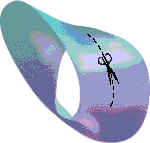The Möbius Challenge: Solution
The Möbius Challenge - Solution
 Imagine you go round the (only!) edge of your Möbius strip, trimming off some small amount - less than half the width. You will go twice around the whole strip, because there is only one edge, and will be left with a Möbius strip in the middle, narrower than the one you started with. That much is easy to visualise. What you probably won't be able
to visualise without doing it is what the bit you trim off looks like - in fact, it will be a thin loop, twice the length of the original Möbius strip, with four twists in it - the original strip only had one.
Imagine you go round the (only!) edge of your Möbius strip, trimming off some small amount - less than half the width. You will go twice around the whole strip, because there is only one edge, and will be left with a Möbius strip in the middle, narrower than the one you started with. That much is easy to visualise. What you probably won't be able
to visualise without doing it is what the bit you trim off looks like - in fact, it will be a thin loop, twice the length of the original Möbius strip, with four twists in it - the original strip only had one.
The best way to see what happens when you cut a Möbius strip in half is to imagine you're trimming off so much of the original strip that nothing is left in the middle. So you'll only be left with a loop of twice the length and half the width of the original strip, with four twists in it - the Möbius strip has vanished completely.
Now it's easy to work out what happens when you mark your strip at one point into n parts, and cut along each of them. First cut 1/n of the way in from the side: this will give you a Möbius strip that is (n-2)/n the width of the original, and a linked loop of double the length, and width 1/n, with four twists. Then you repeat the procedure with the Möbius strip, again trimming off a loop of double the length and width 1/n. You keep doing this until either:
- If n was even, you are left with a loop of width 2/n, and when you cut this, you finally end up with n/2 linked loops of width 1/n, each with four twists in it.
- If n was odd, you finally end up with a Möbius strip of width 1/n, and (n-1)/2 linked loops with twice the length of the original strip, width 1/n, and four twists.
Do the twist (again)
What you get when you bisect strips with more than one twist also depends on whether the number of twists is even or odd.
- If you bisect a strip with an even number of twists you get two loops, each with that same number of twists. So a loop with 2 twists splits into two loops, each with 2 twists, and so on.
- If the number of twists n is odd, you get one loop with 2n + 2 twists. Checking this against the case we already know, this formula does indeed give us the right result - a strip with 1 twist becomes a loop with 2+2 = 4 twists.
Cooper
I am confused as to why a strip that has been twisted 360 degrees will interlock once cut in half?
Jivan Scarano
Because you're cutting it into two pieces (unlike when there's one twist), and the two edges are already twisted through each other before you start cutting.